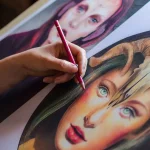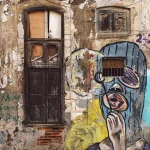The Role of Art in Society: Why Art Matters

From the early cave paintings, art was part of human civilization to this date, where digital art thrives. It is much more than aesthetics, for it shapes cultures and inspires transformation; it offers a powerful medium of self-expression. Only when the true function of art in society is understood, does its depth and why it has remained relevant in life today, come forth. Art, here, creates community and changes the way we think as it enriches the human experience.
1. Art as a Reflection of Culture and History
Art captures an aspect of time, place, and community, recording history for future generations.
- Recording History: Art has documented events, movements, and even changes in society. From the cave paintings of ancient times to murals and photographs documenting social movements, art visually chronicles human history.
- Cultural Identity and Representation: Every culture has its unique forms of art, which relate to values, beliefs, and traditions. For example, Indigenous art appears to be a tradition frozen in time, having been passed down through generations, while African tribal arts use specific symbols and rituals pertaining to each community.
- Bridging Generations: Art offers a bridge between generations. It provides them with a way to pass along stories and cultural heritage to be remembered. This continuity lends individuals a feeling of identity and belonging.
It is art that reflects and preserves cultural identities, reinforcing the very diversity and richness of our shared history.
2. Art as Means for Individual Self-Expression
The medium of art allows an individual to express emotions, thoughts, and insights that may be elusive or hard to put into words.
- Therapeutic Benefits: Art tends to be therapeutic in nature for creating emotions and reducing stress within a person. Art has also been used as a medium of therapy wherein through it, people are helped in expressing their feelings that they may not be able to bring out verbally.
- Celebrating Individuality: Art allows people to develop their own personas, their own set of ideas and beliefs, and experiences. No two artists think alike; each one brings uniqueness and adds variance to the fraternity of art, making room for new and individualistic voices.
- Inner Awareness: The process of creating art and perceiving it brings inner cognitions and values into light. In this respect, self-reflection maximizes personal insight into oneself and a place within the world.
The medium itself is a strong one for self-expression as well as personal development whereby persons come to know and learn something about themselves and the inner world they possess.
3. Art and Social Change

The arts have been used as a vessel for societal change in order to address critical issues and bring about thought, discussion, and action.
- Awareness: The arts make artists more aware of social injustices, ecological concerns, and human rights. For example, Picasso’s “Guernica” brought attention to the tragedies of war.
- Inspiring to Action: There is the possibility of, through art, motivating people into taking action and joining causes; visuals in campaigns for social justice, equality, and environmental sustainability often build powerful imagery that resonates with audiences.
- Giving Voice to the Margins: Art gives voice to the voiceless. Works from LGBTQ+, Black, and Indigenous artists represent perspectives that dismantle stereotypes and foster empathy and understanding.
Art provides a powerful impetus for social change through its power to provoke and evoke empathy, thus building awareness and inspiring action.
4. Art as an Economic Driver
The role of the arts in society extends into economic benefits-contributing a great deal to local and national economies.
- Employment Creation: The arts and culture industry provides employment opportunities for millions worldwide. Artists, those who curate shows, owners of galleries, among others, depend on them for livelihood.
- Tourism: The art attracts tourists who come to see the galleries, museums, and cultural festivals, putting money into the local economy. Various cities such as Paris, New York, and Florence are noted for this reason and have attracted millions of visitors annually.
- Economy Boost: Art festivals, public installations, and art galleries lead to footfalls, benefiting restaurants, hotels, and retail stores in the vicinity.
The economic value of art demonstrates the fact that investment in the arts can fortify community finances while also cultural enrichment.
5. Strengthens Education and Learning
Art in education aids in gaining various skills and nurtures creativity among growing children.
- Nurturing Critical Thinking: Ability to share in art as a means of expressing oneself automatically ignites reasoning and critical thinking within the students. It actually teaches them to analyze, question, and look at things from a different perspective-things that come in handy for any student in any field.
- Fostering Creativity: Creative activities bring forth creativity where students are always encouraged to think out of the box and propose novel solutions for any given problem. Students find this useful during their careers in such fields as scientific, technological, business, and social science-related areas.
- Improvement in Academic Performance: Studies have identified that students who study the arts tend to achieve higher academic results. Arts education develops concentration, self-discipline, and hard work, which improve the overall academic performance.
Art education makes holistic learners because it empowers students with skills that are useful both academically and professionally.
6. Art Enhances Mental and Emotional Health
Participating in art was shown to enhance mental health and well-being by bringing feelings of comfort, community, and even inspiration.
- Reduce Stress: Looking at or making art reduces stress and anxiety because it is quiet respite, and induces relaxation. Making art helps individuals disengage from daily concerns and enter a state of flow.
- Boost Mood: Exposure to the beautiful and creative is likely to lift mood and increase the positive emotion. For many, going to an art gallery or making art would be an uplifting activity.
- Empathy and Connection Building: Art builds empathy because experiences and perspectives are presented. Such a connection with the emotions of others, their stories, helps develop understanding and reduces feelings of isolation, which in turn improves well-being.
These mental health benefits of art make it one of the indispensable features in emotional and psychic health, thereby making the lives of people much more rewarding on an individual level.
7. Art Strengthens Community Bonds
Art possesses the intrinsic talent to bring disparate persons together and foster a feeling of camaraderie.
- Public Art Projects: Murals, sculptures, and installations create communal spaces where people can come together. Public art projects often involve local artists, thus fostering pride and ownership within the community.
- Creating a Shared Identity: It allows communities to speak out about their identity, showing what makes them unique. This may foster intimate relations among residents and create a sense of belonging.
- Building Relationship Across Cultures: In every aspect, the arts bring people from different cultures together by exhibiting their various standpoints. Art festivals, galleries, and museums are representatives from mixed backgrounds, hence helping to facilitate dialogues and understanding.
People connect, and diversity is celebrated; social cohesion is contributed to by the shared art experiences.
Conclusion
Great and multi-field is the role of art in society; it comes into our lives very often unnoticeably. It helps to preserve culture, promote self-expression, contribute to economic growth, and further education. It is for these reasons that art comes in extremely handy in the life of humans. As a catalyst for social change, a source of emotional well-being, and a way to unify people, art matters immensely in this world.
Grasping this importance of art reminds us that it is not a luxury or an afterthought but is integral to our culture and identity as human beings. While we live in a world that changes from second to second, art remains durable: part of the fiber of our values, emotions, and dreams that belie the fact that art, indeed, matters.
Read also: How Practicing Mindfulness Can Enhance Your Physical and Mental Well-being











